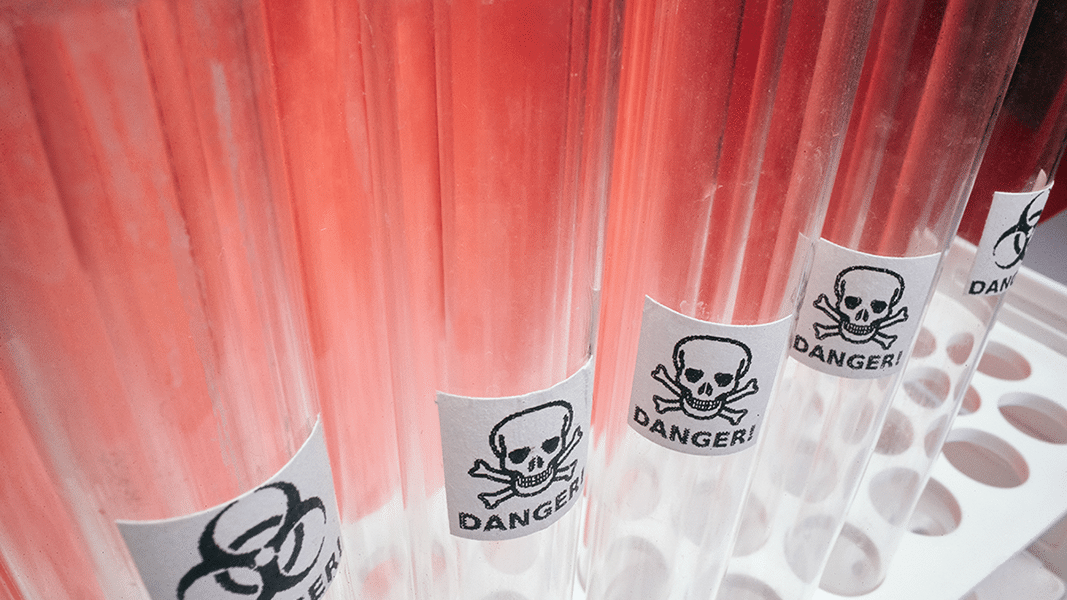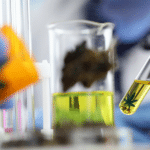A cannabinoid is any molecule that interacts with at least one of the body’s two cannabinoid receptors, CB1 and CB2. This large class of chemicals can be divided into three parts: those produced by cannabis, called phytocannabinoids; those produced within the body, called endogenous cannabinoids or endocannabinoids; and those produced in a lab (that don’t also exist in nature), called synthetic cannabinoids. It’s this latter class of novel molecules, encompassing valuable research chemicals and dangerous street drugs alike, to which we turn our attention.
Project CBD has covered synthetic cannabinoids several times in the past, including their potential role in the 2019 vaping crisis. And they continue to be a subject of considerable interest among chemists, medical researchers, pharmaceutical companies, law-enforcement, legal experts, public-health officials, and drug users.
In the scientific literature, synthetic cannabinoids can be further categorized according to their primary role: as tools for learning more about cannabinoid receptors and the broader endocannabinoid system (ECS); as potential therapies for specific human health conditions; or as potentially dangerous recreational drugs, which proliferate in a world where safer, cannabis-derived cannabinoids are still mostly banned (even, in many cases, for research purposes). These difficult-to-detect, easy-to-make synthetic compounds have in many cases moved from the lab to the drug scene after being described in a research paper.
Much of the new pre-clinical research that Project CBD reports on involves the use of synthetic cannabinoids to tease out various aspects of ECS function or investigates the potential of other synthetics to treat human disease. But a few recent studies focus on these man-made molecules’ third guise as street drugs.
THC & JWH-018
The molecule known as JWH-018 (the initials come from its creator, John W. Huffman, who was a professor of organic chemistry at Clemson University) is a potent synthetic cannabinoid with an affinity for the CB1 receptor five times greater than that of THC – meaning, roughly speaking, that one-fifth the dose elicits a similar effect. JWH-018 also was possibly the earliest synthetic cannabinoid to escape the lab and appear on the streets in the early 2000s, most famously as an ingredient in the grey-market drug “Spice.”
Although JWH-018 has since been banned in several countries (and replaced with new synthetic chemicals differing by a single atom), it remains in use in large parts of the world1 – and thus is a worthy subject for researchers. A team at the Netherlands’ Maastricht University recently evaluated the compound’s effects alongside THC. Their goal was to demonstrate a method for comparing the neurocognitive and psychotomimetic profiles of THC and JWH-018 by equalizing them not according to measured dose but by “psychotropic” equivalence – in other words, subjective high according to human subjects in earlier placebo-controlled studies by the same research group.
The findings of the new study, published in May 2022 in the journal Frontiers in Psychiatry,2 indicate that at equivalent subjective intoxication levels THC and JWH-018 are actually not as different as they seem. Both impaired subjects’ performance at psychomotor, divided attention, and impulse control tasks, with no significant differences between them. Both also produced what the researchers deemed significant psychotomimetic effects (resembling symptoms of psychosis), according to subjects’ questionnaire responses. The main difference was that dissociative effects were considerably more pronounced for JWH-018 than THC.
But in the real world – due to the sky-high potency of JWH-018 and similar synthetic cannabinoids, and the inconsistent content of illicit smoking mixtures – the authors encourage considerable caution: “It is very difficult for users to predict the maximal subjective high,” they write, “resulting in very unpredictable neurocognitive outcomes and common overdosing.”
Mepirapim & Spice
Mepirapim is a synthetic cannabinoid first mentioned in the scientific literature in 2013 after it was detected in illegal herbal mixtures in Japan.3 The substance later appeared in a 2015 article out of Japan suggesting it could cause heart failure and death in combination with other drugs,4 and in another in 2017, where the authors, again based in Japan, reported on the case of two individuals who had used it recreationally alongside acetyl fentanyl, an analog of fentanyl.5 One of the young men inhaled the drugs and survived; the other took them intravenously and did not.
Mepirapim’s poor reputation is further augmented by its affiliation with John W. Huffman’s infamous “Spice” ingredient: “Considering its structural similarity with JWH-018, which is a controlled Schedule 1 substance in the United States, Mepirapim has a high potential to exhibit psychotropic effects and dangerous side effects,” write the Korea-based authors of a June 2022 paper in the journal Pharmaceuticals.6
Still, it’s been lightly studied, with only a few additional references in the scientific literature to date. As such, the researchers sought to further investigate the pharmacology and physiological effects of the drug, with a focus on its addictive potential. Sure enough, they found that Mepirapim treatment “supported the maintenance of intraveneous self-adminstration” in rats compared to a control.
They concluded that the drug “induces addiction-related behaviors through neurochemical maladaptation in the brain” driven by potent activation of the CB1 cannabinoid receptor. But that last point is up for debate as another recent paper addressing Mepirapim and other novel synthetic cannabinoids determined that the drug has “minimal” central CB1 activity and that effects occur through other channels.7
More Synthetic Alphabet Soup
Two additional studies published in May 2022 seek to better understand the pharmacological activity and potential negative effects of synthetic cannabinoids consumed as recreational drugs.
The first, by Belgian and Italian researchers in the journal Drug Testing and Analysis,8 covers a small class of molecules designed expressly to evade legislation passed in China in July 2021 banning synthetic cannabinoids containing one of seven general core scaffolds. These new chemicals, called OXIZID cannabinoids, possess alternative core structures rendering them technically legal – or at least not explicitly illegal.
In their study, the researchers investigated the potency and efficacy (or maximum effect that can be achieved) at both CB1 and CB2 of five members of this new class. All five behaved as full agonists at CB1 and partial agonists at CB2, and one in particular, called BZO–CHMOXIZID, was highly potent at both receptors, marking it as a potential drug of abuse on regulators’ watch list.
The second study, appearing in the journal Toxicology Mechanisms and Methods,9 honed in on a molecule called UR-144, already widely used alone or in combination with other illicit synthetic cannabinoids all over the world. The Turkey-based authors evaluated the molecular mechanism of serious cardiovascular symptoms associated with its use.
They found that UR-144 induced cell death as a consequence of elevated levels of cytoplasmic Ca2+ (a calcium ion and ubiquitous intracellular messenger) and activation of DAPK1 (an enzyme that regulates cell death). While that may be a bit technical for your average drug user or public-health official, it no doubt means that UR-144 is on the research radar. The authors call for studies to further elucidate molecular mechanisms of the drug’s cardiotoxic effects.
Nate Seltenrich, Project CBD contributing writer, is the author of the column Bridging the Gap. An independent science journalist based in the San Francisco Bay Area, he covers a wide range of subjects, including environmental health, neuroscience, and pharmacology. © Copyright, Project CBD. May not be reprinted without permission.
Footnotes
- https://link.springer.com/article/10.1007/s00213-021-05768-0
- https://www.ncbi.nlm.nih.gov/pmc/articles/PMC9160432/
- https://link.springer.com/article/10.1007/s11419-013-0217-2
- https://onlinelibrary.wiley.com/doi/full/10.1002/ams2.182
- https://pubmed.ncbi.nlm.nih.gov/29367864/
- https://www.mdpi.com/1424-8247/15/6/710/htm#B17-pharmaceuticals-15-00710
- https://pubs.acs.org/doi/10.1021/acschemneuro.1c00822
- https://analyticalsciencejournals.onlinelibrary.wiley.com/doi/full/10.10…
- https://www.tandfonline.com/doi/full/10.1080/15376516.2022.2081829?scrol…
Recommended Readings
Under the Radar: Synthetic Cannabinoids & EVALI
The CDC’s diagnostic criteria for EVALI parallel the symptoms of synthetic cannabinoid use.
Understanding Synthetic Cannabinoids
A neuroscientist critiques the New York Times report on “Spice,” an illicit synthetic cannabinoid.
Special Report on Cannabinoids & Chirality
The promise and pitfalls of synthetically produced CBD.










